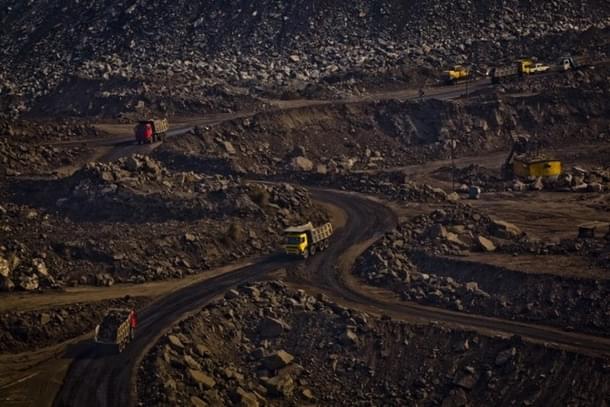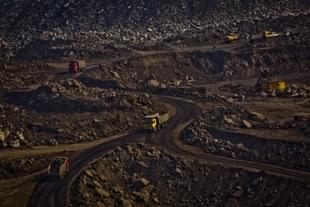Ideas
Why The 'Coal Crisis' Is Actually A Power And Logistics Problem
Pratim Ranjan Bose
Oct 13, 2021, 12:17 PM | Updated 12:17 PM IST
Save & read from anywhere!
Bookmark stories for easy access on any device or the Swarajya app.


Politics is not merely restricted between Bharatiya Janata Party (BJP) and Congress or Trinamool Congress, there are many shades of it and terminology is part of politics. So, we see a ‘coal crisis’ — not a power crisis or logistics crisis — even though sufficient fuel is available in the country to fire power stations at the current level of demand, for the next three weeks, without a single ounce of additional supplies.
With rains receding and winter about to set in, opencast mining (95 per cent) has stepped into the busy season. From 1.5 million tonne a day in the rainy season, daily production will now cross 2 mt. As winter production doesn’t find enough buyers due to low demand for electricity, the pit-head stock-pile may rise.
Many Unanswered Questions
Right now, CIL has a stock of 40 mt. Power plants should have had a stock of 21.2 days amounting to 39.5 mt but they have barely 7.2 mt (including 1 lakh tonne of imported fuel). CEA listed 115 of 135 plants monitored by them for having critical stock. Why majority power plants have run out of stock is a million-dollar question.
As on 1 July, when there was no talk of a “coal crisis” and the pit-head stock was even higher, the national average coal stock at plant-end was equivalent to 15 days, two-third of ideal. Moreover, there were 40 odd plants with less than 10 days stock. Roughly half of them had less than seven or even five days' stock. However, CEA didn’t flag any plant for critical fuel stock.
A comparison of CEA’s daily coal stock on different dates during July-October will tell, plants that were maintaining lower stock than average, were the first to run out of fuel. It is hard to find a trace of politics in coal distribution. There were plants from states like Gujarat, Maharashtra, Telangana, Odisha, which were always well-stocked.
West Bengal had its share of bad and good apples. Plants run by DVC and CESC have been well-stocked all through. However, of the seven state government-controlled plants, one had seven days stock on 1 July, the rest had four days stock.
The reference of central government-run NTPC is avoided as it operates pit head plants mandatorily aided with merry-go-round (rail) coal evacuation logistics. Barring exceptional cases, raw material availability has never been an issue with them.
There are many unanswered questions in the whole episode: why CEA didn’t flag ‘critical stock' with plants till August when the government suddenly asked power plants to ‘consider’ coal imports? In fact, it is not known why the government asked for it (imports) at all.
Yes, lower generation on wind and hydroelectricity (due to late rains) coupled with demand spike created an imminent shortfall scenario. Leaving logistics issues apart, it is questionable if high-priced imported coal is any solution in India, which is witnessing a widening gap between average cost (ACS) of supply and average revenue requirement (ARR).
According to a NITI Aayog publication, from 0.54 a kilowatt-hour (kwh) in FY16, the ACS-ARR gap widened to Rs 0.72/kwh in FY19 as the Narendra Modi government added more rural subscribers and improved the average daily availability of electricity to rural areas to over 22 hours.
The most interesting episode of this issue is a newspaper story, in end-September, quoting intra-government communication wherein CIL is blamed for not doing enough. Without getting into who is responsible for what, such stories were seen last time during UPA-II, particularly at the peak of the coal controversy.
The UPA government went on offering linkage (LOA), a preliminary promise for coal supply, to power investors, ignoring CIL’s views on production potential. As the CIL board expressed inability to honour those linkages in their entirety, UPA issued a presidential decree to force CIL. It didn’t work, because there was no coal. CIL supplied fuel but only partly.
The most interesting part of the story is: power lobby then forecasted massive electricity shortage for non-availability of fuel. In reality, the power generation sector ran into trouble due to the non-availability of PPA (power purchase agreement). (There were some states, avoided by IPPs, who promised high power prices, but kept payments due for years).
Reforms Due In Power
Coal and power both suffer from some common ills in India. Despite repeated reforms and huge private sector investment in generation (46 per cent), a free market couldn’t be established in electricity. Coal mining is just denationalised and the market is restricted to imported coal, mostly used in cement, fertiliser, steel etc.
Among the differences, compared to a CIL centric monolithic coal sector; electricity is more complex. The Centre and states control roughly 25 per cent each of the generation capacity. The private sector controls half of the 388GW (gigawatt) generation capacity but they have no control over prices and operate under unequal terms.
As in FY20, the average plant load factor (PLF) in coal was 56 per cent, central sector 64 per cent, state 50 per cent and private 54 per cent. In layman’s terms, it means nearly half of the private capacities are idling.
Lower the plant utilisation higher is the generation cost. But IPPs are forced to participate in tariff-based bidding for PPAs. In contrast, the state sector enjoys a cost-plus tariff and higher plant utilisation.
Electricity policy 2005, promised tariff-based competitive bidding for all from January 2011. But it didn’t happen as the Electricity Act, 2003, was not duly amended. The issue is now before the Supreme Court and there is a strong vested interest on the part of NTPC and state governments — who also control 90 per cent of distribution business— keep the story going.
The case is the worst for state government-run gencos. Most of them are old, suffer from poor technology and high operating cost (low fixed cost due to amortisation of land assets is the only positive), bear the legacy of control-economy and in many or most cases they are located far away from the coal-producing zones.
Consider this: roughly 25 per cent of domestic coal production travels more than 700 km to reach the plant from the pit-head. Over 10 per cent cross 1,000 km or more. The freight impact is 50 to 100 per cent the ex-mine price of fuel. Apart from the high landed cost of fuel, they block railway rolling stock for a longer period, impacting the overall speed of coal evacuation.
It is pertinent to question why far away states like Tamil Nadu, Rajasthan or Punjab do not buy electricity from idling pit-head capacities instead of taking coal and generating power in respective states? And, how does states justify such a high cost of generation and procurement (at cost plus)?
The main reason is the political aspiration to give free or cheap electricity and buy votes. No political party wants to forgo that control. This is why they oppose reforms in the distribution sector. But this is clearly beyond their means. So, they opt for different techniques to rig the system.
Buying electricity at cost-plus mode from state gencos gives them flexibility in payments. State-level electricity regulators operate under the thumb of ruling politics. So ‘regulatory assets’ (shadow outstanding) keep rising on the books of utilities. DISCOMs don’t pay to state gencos, who default coal dues. CEA coal data has listed many plants where supply is regulated for payment issues.
Blame Game Will Not Help
India produces less coal than the total demand. So, there has been an overall shortage. But this cannot be solved overnight. Even if we assume coal is produced, the railway doesn’t have capacity to move it. Also, CIL is no epitome of efficiency. But blaming them for the low rainy-season fuel stock at power plants is a travesty of justice.
The global supply issues and the spike in the energy market indeed have its impacts on the Indian coal market but it is the non-power sector which are facing the brunt, as CIL is diverting their quota to the power sector as an emergency measure.
CEA data is a clear proof that to cut corners many state gencos and IPPs stocked less fuel for the rainy season. No one flagged the issue then. Now everyone is looking for a scapegoat.
If the availability of fuel is the real issue, why does Punjab want to scrap PPA with well-stocked DVC units? Punjab was facing an electricity crisis from July. Was it due to coal or they don’t have money?
Barring unforeseen scenarios, the “coal crisis”, in its present form, will be over soon. The government is now putting its entire effort to ensure logistics and set priorities for supply. This is a proven method that came to much use in 2015, due to excessive heat and a drop in captive production.
There are, however, two differences. First, the 2015 crisis was real. The deallocation of captive mines reduced the availability of domestic fuel. Second, both coal and power portfolios were then headed by a single minister. The government then preempted the crisis and didn’t allow issues to blow out of proportion.
The situation is reverse in 2021. In terms of domestic coal production and availability, India is in a reasonably comfortable scenario, particularly when compared to China where daily power cuts became a norm in Shanghai or Beijing. Yet, India got bad press.





